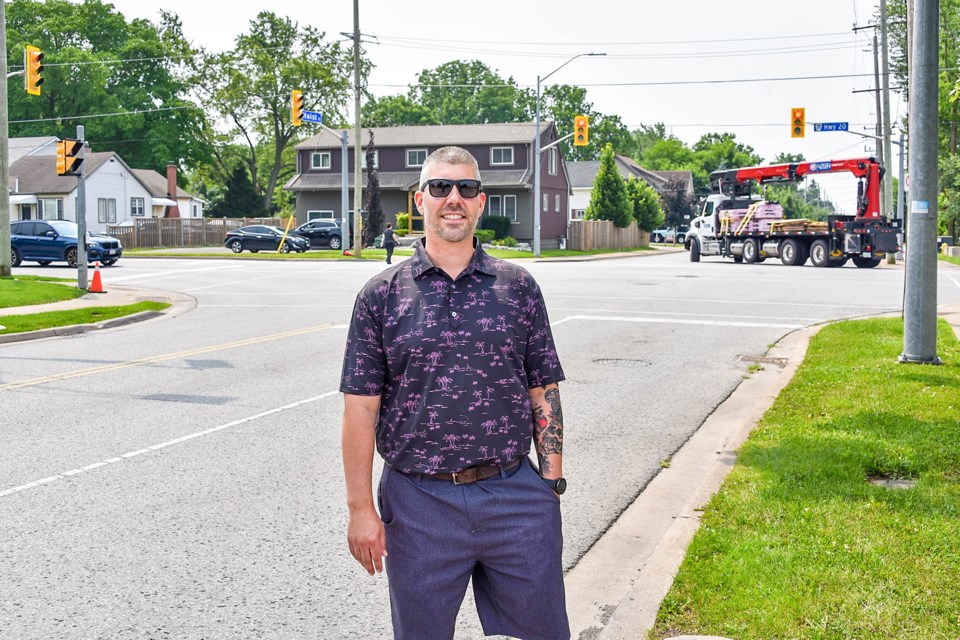Originally published on July 18 2023
Jamie Boisvert’s son Aidan is seven years old, and going into Grade 2 at A. K. Wigg Public School in September. Living on Abbott Place in the Lookout Point neighbourhood, he is one of approximately 20 students from the subdivision that attend A. K. Wigg. When Aiden was in junior kindergarten, District School Board of Niagara (DSBN) policy dictated that he was eligible for bus transportation to school. But given that he is inside the 1.6 kilometre designation which applies to elementary school grades, he now needs to find his own way to school.
“This does not seem reasonable to me, when the bus service is available to kindergarten and special needs students in the subdivision,” said Boisvert. “The bus is never full. Not allowing older children to go on the same bus is not only inefficient, but also puts these elementary school kids at risk.”
Boisvert said that intersection at Haist and Highway 20 is dangerous.
“There is a gas station with a Tim Horton’s on the corner, and pedestrians are routinely nearly struck by vehicles trying to get in the drive-thru lane. I've witnessed several accidents, and adults getting hit by speeding vehicles in the morning. This is not safe for anyone to cross, especially kids trying to navigate that situation every day. The crossing guard is oftentimes not available to assist, because they must manage a highway intersection that has many speeding motorists that blow through the red light.”
There is a big concern about the stop signs at Brewerton and Haist as well, he said. “People in the neighbourhood regularly see vehicles blow through without stopping.”
A lack of police presence in Pelham could be part of the traffic enforcement issue, said Boisvert, who said he speaks for a significant number of families in the Lookout Point neighbourhood on this issue.
“We would like the DSBN to reconsider, and offer a bus service to ensure that all students are safe, and to minimize our carbon footprint by reducing the many different modes of transportation to the school twice a day.”
Sarb Sandhu, the Executive Director for Niagara Student Transportation Services, responded to Boisvert via email that “the DSBN’s transportation policy ensures that standards are applied consistently and equitably, without deviation, for all students within the Niagara Region. We currently have neighbourhood stops within your area because of eligible kindergarten students. As you are aware, by board policy, your address is not eligible for transportation. When families do not qualify for bussing, as is the case for 23,000 students in the Region, it is the parent’s responsibility to determine the appropriate method to get their child to and from school safely. This may include, but is not limited to, driving them to school, arranging for family or friends to help, finding a walking partner within the neighborhood.”
Sandu wrote that he recognized the corner of Highway 20 and Haist Street is a high-traffic area, and that families must exercise added diligence when in this vicinity.
“The safest walking route to school would involve crossing Haist Street at Brewerton and proceeding south, down the east sidewalk of Haist Street to avoid the commercial plaza entirely,” he wrote. “The intersection at Brewerton and Haist Street is both controlled by a three-way stop, and is in a community safety zone. The Town of Pelham has confirmed that there are four crossing guards located at Haist/Highway 20, Haist/Canboro Road, Haist in front of A. K. Wigg, and Haist/Pancake Lane to support active school travel and pedestrian safety.”
Sandu also noted that the Niagara Regional Police have been contacted regarding speed and safety enforcement strategies in the area.
Nancy Beamer, Pelham’s DSBN trustee, provided PelhamToday with the DSBN transportation policy (https://policy.dsbn.org/J-01), and commented that “while I understand the parents’ concerns regarding safety, and the fact that younger siblings can ride the bus, with over 44,000 students in the DSBN, you can imagine the chaos that would ensue if an exception was made for any one group. This has nothing to do with budget cuts or driver shortage. The policy has been in effect for many years and is reviewed on a regular basis.”
Boisvert is not satisfied with the status-quo answers he has received.
“Who made the decision on this policy? Is it about cost savings? If it is, we’d be prepared to pay something for the service,” said Boisvert. “Maybe make the cutoff for transportation after Grade 4, when the kids are age nine or ten, and better aware of the dangers of traffic. That would be fine. But I'm not comfortable having my seven-year-old navigate his way through these danger spots on his own.”
